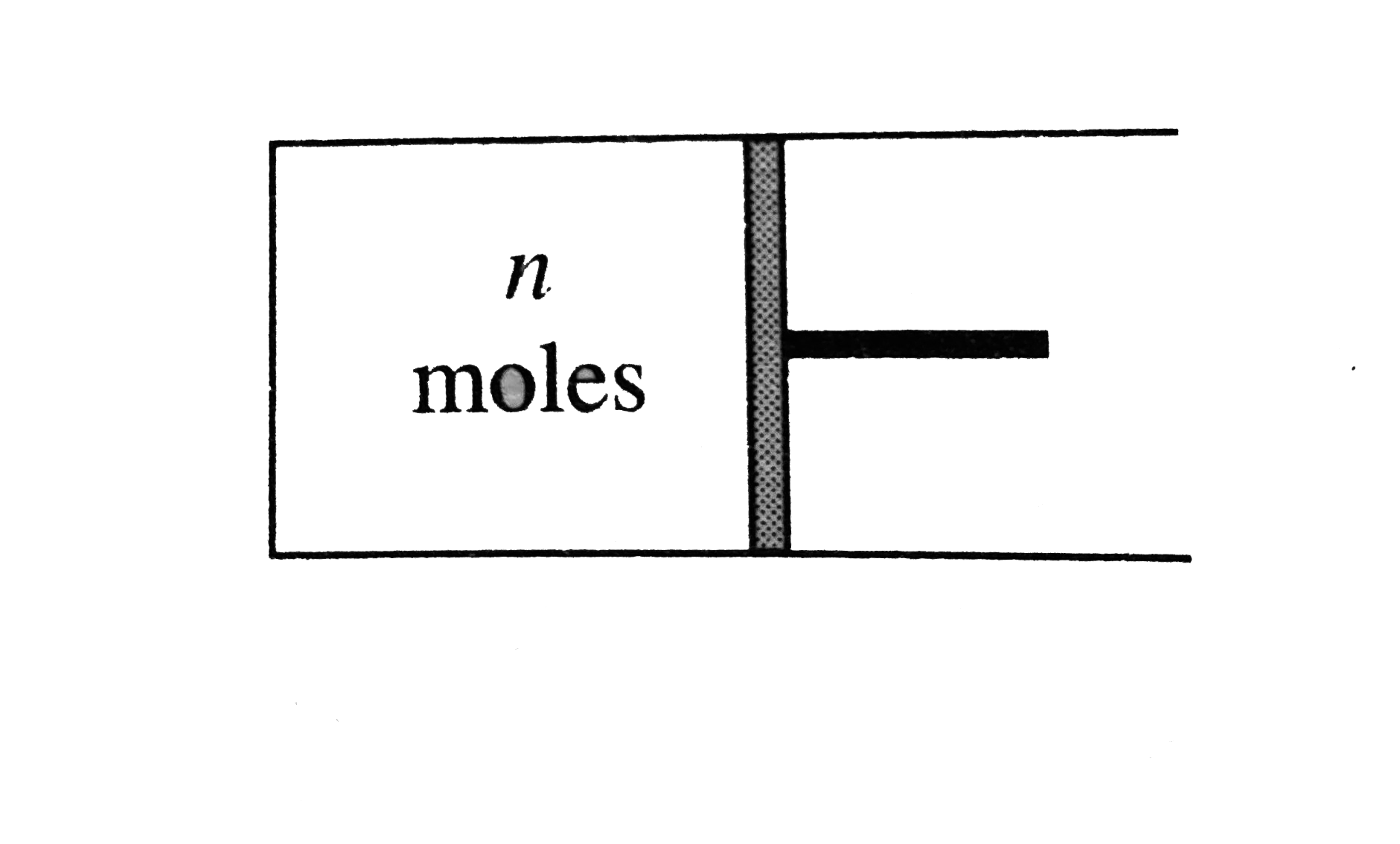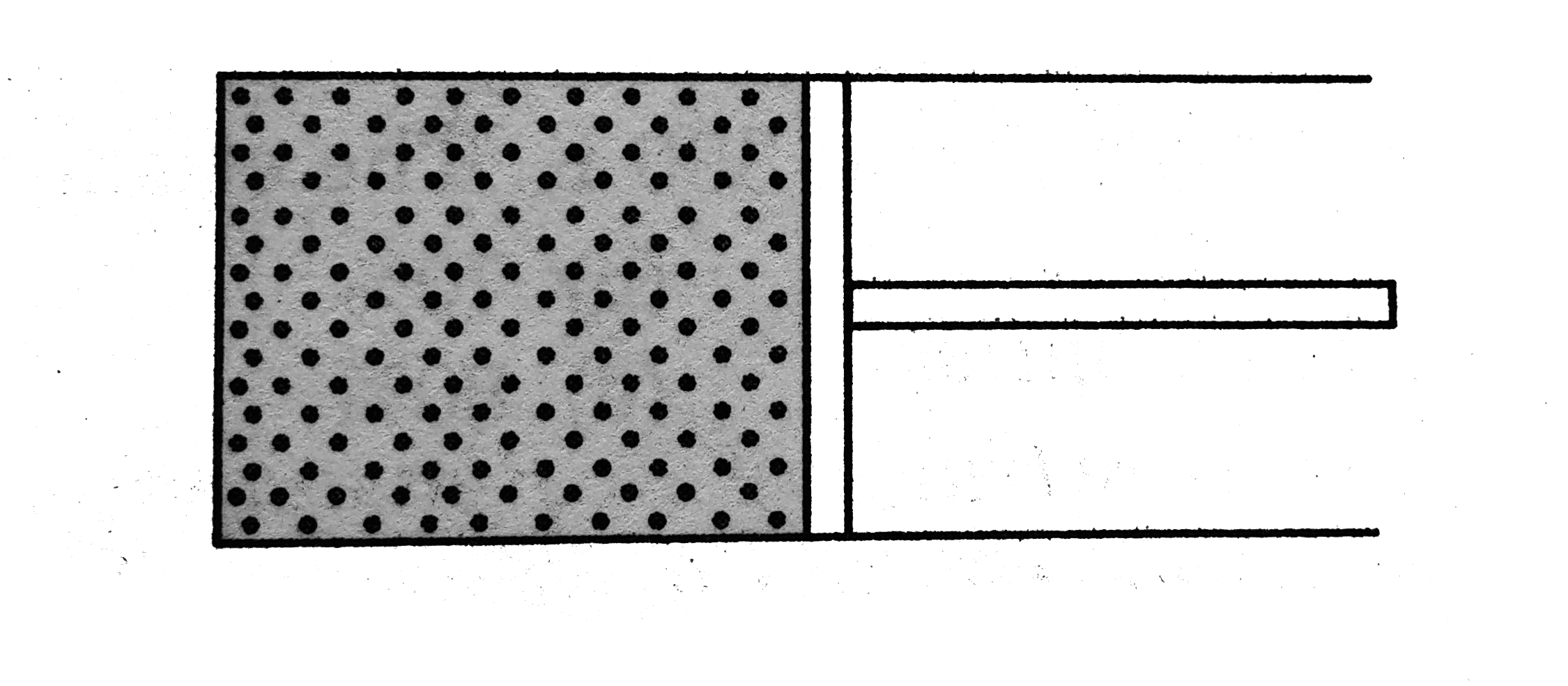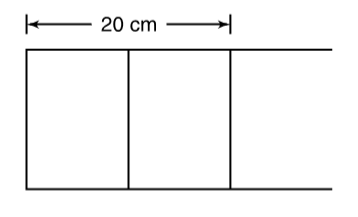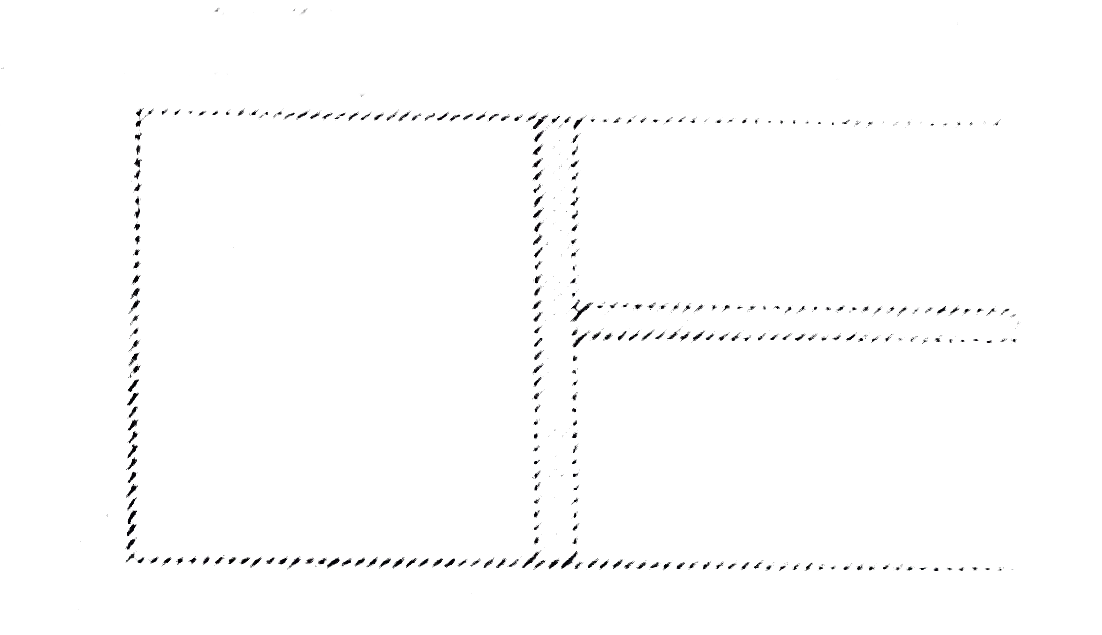The cylinder shown in the figure has conducting walls and temperature of the surrounding is T, the piston is initially in equilibrium, the cylinder contains n moles of a gas, Now the piston is displaced slowly by an external agent to make the volume double of the initial. Find work done by external agent in term of n, R, T

1st Method:
Work done by external agent is positive, because Fext and displacement are in the same direction. Applying equilibrium condition when pressure of the gas is P
PA+Fext=PatmA
Fext=PatmA−PA
Wext=∫d0Fextdx
=∫d0PatmAdx−∫d0PAdx=PatmA∫d0dx−∫2VVnRTVdV
=PatmAd−nRTIn2
=Patm.V0−nRTIn2=nRT(1−In2)
2nd Method
Applying work energy theorem on the piston
As Wall=ΔK.E
ΔK.E=0 (given)
Wgas+Watm+Wext=0
nRTInVfVi−nRT+Wext=0
Wext=nRT(1−In2)
Topper's Solved these Questions
- BOOK - RESONANCECHAPTER - KTG & THERMODYNAMICSEXERCISE - Solved problem1videos
KTG & THERMODYNAMICS
- BOOK - RESONANCECHAPTER - KTG & THERMODYNAMICSEXERCISE - Problem3videos
KTG & THERMODYNAMICS
- BOOK - RESONANCECHAPTER - KTG & THERMODYNAMICSEXERCISE - SUBJECTIVE QUESTIONS27videos
KTG & THERMODYNAMICS
- BOOK - RESONANCECHAPTER - KINETIC THEORY OF GASES AND THERMODYNAMICSEXERCISE - Exercise64videos
KINETIC THEORY OF GASES AND THERMODYNAMICS
- BOOK - RESONANCECHAPTER - MAGNETIC FIELD AND FORCESEXERCISE - Exercise65videos
MAGNETIC FIELD AND FORCES
Similar Questions
A heat conducting piston can move freely inside a closed, thermally insulated cylinder with an ideal gas (γ= 5/3). At equilibrium, the piston divides the cylinder into two equal parts, the gas temperature being equal to 300 K. The piston is slowly displaced by an external agent. Find the gas temperature when the volume of the greater section is seven times the volume of the smaller section.
View SolutionA horizonal piston-cylinder arrangement is placed in a constant temperature bath.The piston slides in the cylinder with negligible friction, and an external force holds it in place against an initial gas pressure of 14 bar.The initial gas volume is 0.03m3
(a)The external force on the piston is reduced gradually, allowing the gas to expand until its volume doubles.Calculate the work done by the gas in moving the external force.
(b)How much work would be done if the same expansion is carried out by removing a part of the external force suddenly.Also calculate % efficiency of this process as compared with the reversible process (%of reversible work).
Take ln2=0.7
Report your answer as (% efficiency ×0.7).View Solution
Knowledge Check
- Question 1 - Select One
n moles of a gas are filled in a container at temperature T. If the gas is slowly and isothermally compressed to half its initial volume, the work done by the atmosphere on the gas is
 AnRT2B−nRT2CnRTIn2D−nRTIn2
AnRT2B−nRT2CnRTIn2D−nRTIn2 - Question 2 - Select One
A cylinder fitted with a piston contains 0.2 moles of air at temperature 27∘ . The piston is pushed so slowly that the air within the cylinder remains in thermal equilibrium with the surroundings. Find the approximate work done by the system if the final volume is twice the initial volume
A543 jB345 jC453 jD600j - Question 3 - Select One or More
Figure shows initial state of an ideal gas trapped in a container with conducting walls and a piston (mass m) which can move without any friction. The container is placed on point supports and its wall are conducting. Assuming that atmospheric pressure is P0 and the mass of the ideal gas is negligible as compared to the mass of the piston and the mass of container. Take the cross section area of piston to be A. The piston is slowly lifted by an external agent and held in its position. Let M be the maximum mass of container so that it may "lift off" while pulling the piston upwards and Pi be the pressure of ideal gas in initial state. Pick the correct choice:
 APi=P0+mgABPi=P02+mg2ACM=m2DM=P0A2g−m2
APi=P0+mgABPi=P02+mg2ACM=m2DM=P0A2g−m2
A short electric dipole of dipole moment P is placed in stable equilibrium in uniform electric field E as shown in the figure. The work done by the external agent to rotate the dipole slowly up to its unstable equilibrium will be
View SolutionA heat conducting piston can move freely inside a closed thermally isolated cylinder which contains an ideal gas. In equilibrium the piston divides the cylinder in two equal parts, the temperature of the gas being T0. The piston is slowly displaced. Find the temperature of the gas when the volume of one part is n times greater than that of the other part. The adiabatic exponent of the gas is γ.
View SolutionIn a cylindrical container two pistons enclose gas in two compartments as shown in the figure. The pistons have negligible thickness and can move without friction. The sys- tem is originally in equilibrium. The outer piston is slowly moved out by 10 cm and the inner piston is found to move by 4 cm. Find the distance of the inner piston in equilibrium from the closed end of the cylinder if the outer piston is slowly moved out of the cylinder. Assume temperature of the gas to remain constant.
 View Solution
View SolutionAn ideal gas is enclosed in a vertical cylindrical container and supports a freely moving piston of mass M. The piston and the cylinder have an equal cross-sectional area A. Atmospheric pressure is p0 and when the piston is in equilibrium, the volume of the gas is V0. The piston is now displaced slightly from its equilibrium position. Assuming that the system, is completely isolated from, its surroundings, what is the frequency of oscillation.
View Solutionn moles of a gas fille in a a container temperature T is in thermodynamic equilibrium initially. If the gas is compressed slowly and isothermally so half its initial volume volume the work done by the atmosphere on the piston is :
 View Solution
View Solution

